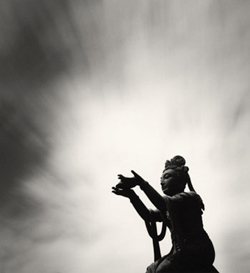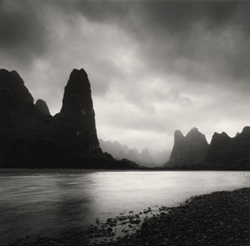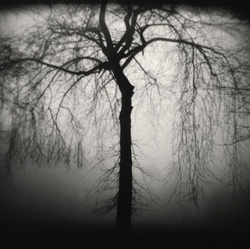A single twisted tree is silhouetted against a luminous sky, reeds emerge from the mist, birds wheel above a flock of sheep, a road curves into the sunset. Each image is exquisite, sufficient unto itself.
A sense of quiet, perfection and timelessness pervades the works of Michael Kenna, one of the world's foremost landscape photographers. All the works are eight by eight inches (20 by 20 centimeters), black and white, meticulously composed and balanced. Some are nocturnes, night exposures, for which he is famous.
Kenna's solo exhibition is underway at the Shanghai Art Museum.
Two of China photographs capture Lijiang River with the mountains of Guilin in the background in the Guangxi Zhuang Autonomous Region.
Kenna, 55, compares his works to haiku, a minimalist Japanese lyric verse form containing 17 syllables and typically describing nature and the seasons.
He seems to capture the essence of Zen.
"I am influenced by Japanese aesthetics," says Kenna who was born in England but lived in Japan for many years. "I got a deep understanding of the play of black and white, entity and void." Space and void are powerful elements - a few posts in a lake, a Japanese torii gate that seems to float in mist.
"I don't describe what is there," he says of some of his pictures. "Instead, I tend to imply one or two elements as the catalyst of my imagination."
They are perfect scenes awaiting the visitor to step inside.
"Once a man steps onto the stage, all the concentration is on him. So I prefer to create space for you, where you are able to imagine that you are the one who is on the stage - my shots are the scenes from your script," says Kenna.
Born in 1953 in England, Kenna graduated from the London College of Printing with a degree in graphic design and commercial photography. The elements of graphic design can be seen in his photos.
Starting in 1980, he began taking a wide range of photos that include nuclear power station chimneys that look like artwork, an empty children's playground, glistening railroad tracks converging at night, formal gardens and greenery, bridges, steel structures and the buildings of Auschwitz concentration camp.
"I would take pictures on the same place and of the same subject for many times," he says.
His purpose is far from simple recording. Documentation, in his view, must be combined with personal aesthetics.
"The result is interpretation, and the object is expressed as a course of change through the rational filtering, not the copy or record of it."
Thus, even the "hellish place" like Auschwitz is transformed into a clear and sober geometrical pattern of beauty, in which there is no sadness or fear. The objects remain the same, but the struggle, the pains and tears have melted into peaceful and harmonious landscapes.
Kenna photographs subjects that might not be beautiful in themselves in a beautiful way. He carefully selects what he needs in his "reality."
In the "natural" photos in the exhibit, there are no buildings, fences or manmade objects to indicate civilization. There is no indication of time. The pictures become abstract signals, with no past or future. Time no longer "exists."
Overwhelming dark shadowing and luminous skies - with light coming from all directions - are powerful elements.
He is also well-known for night photography and for long-exposure art. He is often captivated by unpredictable things when he shoots at night, because it is mysterious with soft and faint light, rich layers and forms.
"You can capture those things that are ignored in the daytime, for example, an automatic watering system," he says. "Sometimes a 10-hour exposure enables you to capture those things that can't be caught by a human eye."
When his camera works at night, Kenna often stays in his car, sits on a bench in a park, barely dozing.
"I have to sleep very lightly, as sometimes I am afraid that the light from a dynamo would ruin one perfect photo," he says.
But why small photos?
"I did some large ones before, but destroyed them," he answers. "Although some people like them, they are not my style."
Far from the trends and movements in photography, Kenna says he prefers his deep and tranquil world with "no one else."
Date: through December 23, 9am-5pm
Address: 325 Nanjing Rd W.
Admission: 20 yuan
Tel: (86)21-6327-2829
(Shanghai Daily December 19, 2007)





